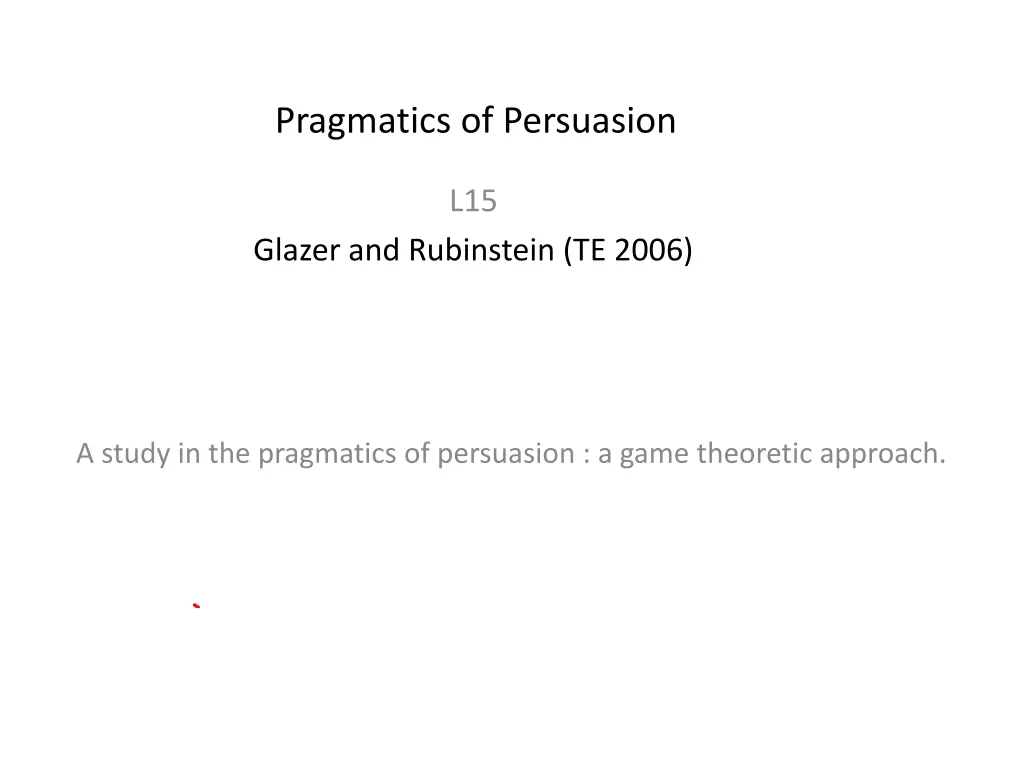
Pragmatics of Persuasion: Game Theoretic Approach
Explore the pragmatics of persuasion through a game theoretic approach, focusing on sender and receiver dynamics, optimal persuasion rules, and message structures. Discover how strategic decisions impact acceptance probabilities in persuasive messaging.
Download Presentation

Please find below an Image/Link to download the presentation.
The content on the website is provided AS IS for your information and personal use only. It may not be sold, licensed, or shared on other websites without obtaining consent from the author. If you encounter any issues during the download, it is possible that the publisher has removed the file from their server.
You are allowed to download the files provided on this website for personal or commercial use, subject to the condition that they are used lawfully. All files are the property of their respective owners.
The content on the website is provided AS IS for your information and personal use only. It may not be sold, licensed, or shared on other websites without obtaining consent from the author.
E N D
Presentation Transcript
Pragmatics of Persuasion L15 Glazer and Rubinstein (TE 2006) A study in the pragmatics of persuasion : a game theoretic approach.
Setup Today - Sender choses which verified fact to reveal - Sender has limited capacity to verify facts - Receiver choses their interpretation Optimal interpretation rule depends on S incentives Pragmatics: A field of linguistics - Interpretation of utterances depends on the context - Cooperative principle (Grice 1989) requires aligned preferences - Noncooperative approach Benz at al. (2006)
A persuasion game Finite state space Action space Sender always prefers Acceptance and rejection region (Arbitrary) type dependent message structure Persuasion rule Rule is deterministic if Rule is finite if
Optimal persuasion rule For probability of acceptance Let Optimal mechanism solves Relative to Glazer and Rubinstein (2006): - S controls which verified facts are revealed - Random decision rule - Abstract (possibly infinite) type dependent message space
Milgroms message structure Assume - Cheap talk with type independent preferences - Trivial optimal rule Assume - Variant of Milgrom s persuasion game - In any PBN equilibrium unraveling of information - Trivial optimal persuasion rule: Problem interesting when high types cannot verify that they are high Example: Vectoric message structure
Example Let Acceptance region Vectoric message structure, capacity two aspects Rule 1: Accept if any two aspects are verified Rule 2: Accept if any to neighboring aspects are verified
3 sets of results 1. Randomization is not needed 2. Optimal rule given by a solution to linear optimization problem 3. Credibility (ex post optimality) 4. Side product: which mechanism is better (GR 2004) or (GR 2006)?
Lemma 1 L: There exist an optimal persuasion rule that is finite Proof: Claim 1: For any there exist finite. such that
Randomization is not needed P1: There exist an optimal persuasion rule that is deterministic. For any type probability of a mistake is Implications (vectoric message structure) - Deterministic mechanism (GR 2004) equivalent to deterministic rule (GR 2006) - Optimal mechanism (GR 2004) weakly dominates optimal rule (GR 2006)
Proof Let be finite optimal mechanism with the smallest number of noninteger values. Suppose
Generalization of L with Vectoric message structure For abstract message structure
Characterization L: Fix . Sum of errors on any satisfies Let be a solution to a linear programming problem P: There exists optimal deterministic mechanism inducing P: Any optimal mechanism is credible
Conclusions Ability to verify facts improves information transmission Skepticism and selective reporting Unraveling of information from the top (frictionless verifiability) Frictions: - Uncertainty about verifiability - Costly verifiability - Capacity constraints
